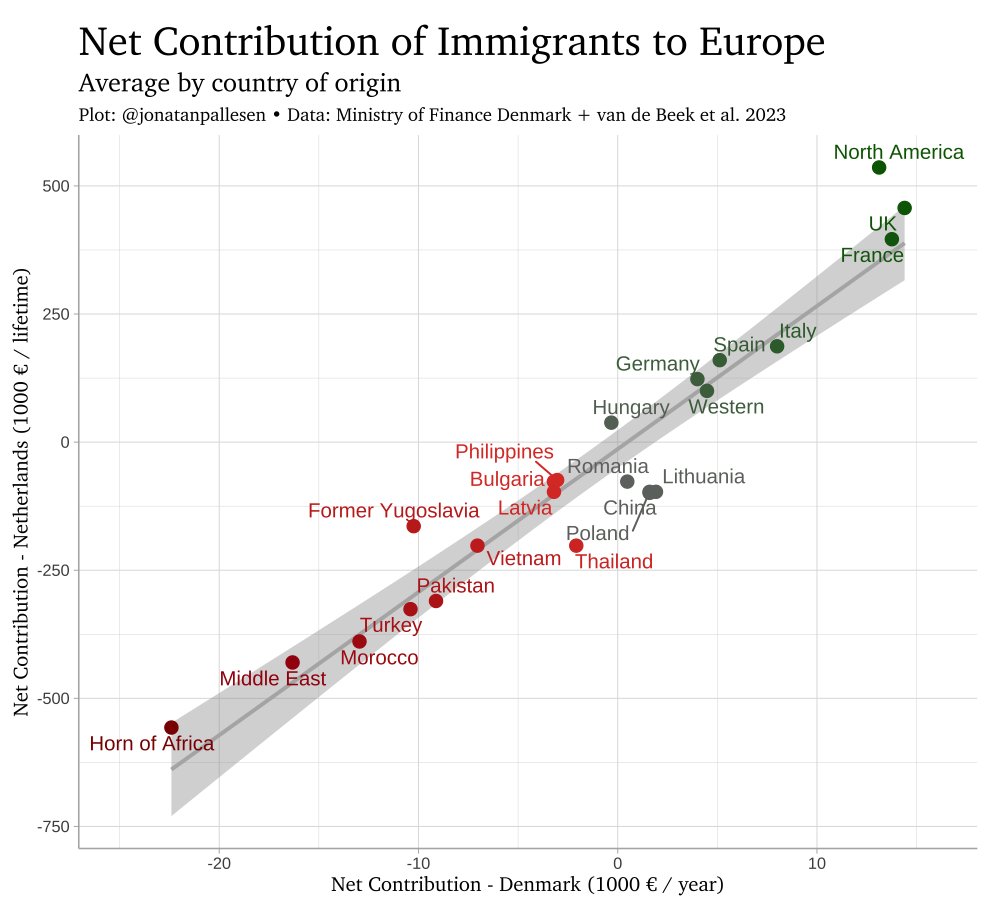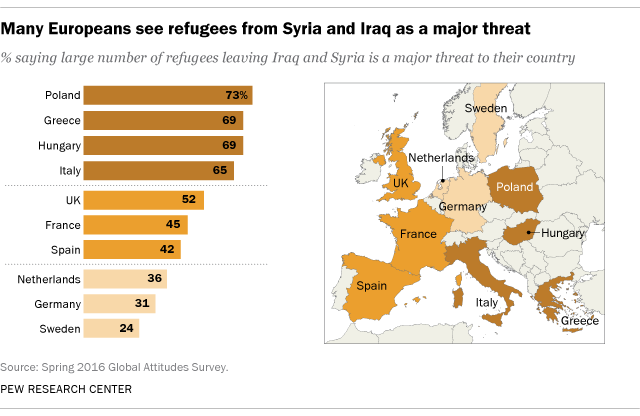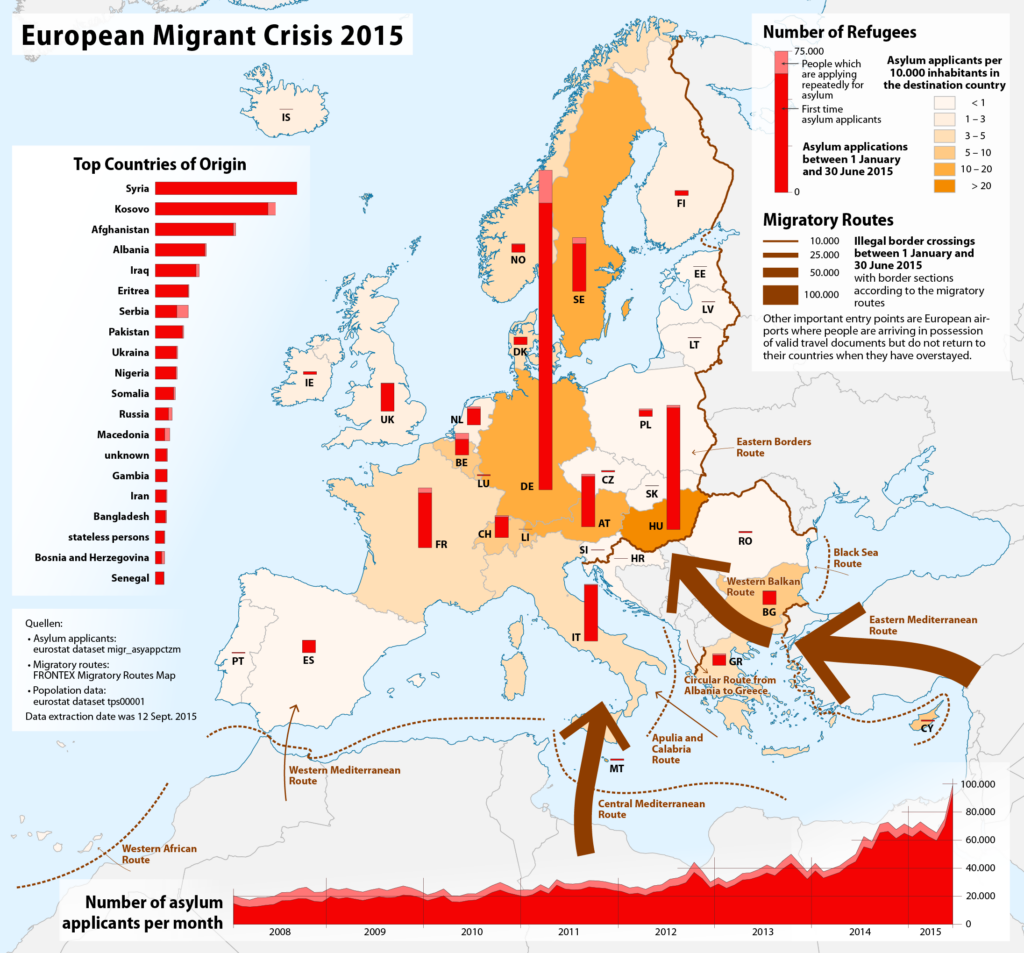
- A 2023 reassessment of previous Dutch and Danish surveys demonstrated that Moroccan and Pakistani populations were net fiscal drains, whereas Western immigrants remained net donors.
- Lower labor market participation rates, higher unemployment, and increased reliance on government-funded social programs such as unemployment benefits, housing assistance, and healthcare subsidies are key causes of this negative contribution.
- The United States, like Europe, has an aging population, and the Migration Policy Institute predicts that immigrants will cover 20% of job openings by 2030, notably in industries like healthcare and construction.
- On the contrary, Indian immigrants have emerged as an economic success story in both Europe and the United States. Their lifetime net contribution of over € 56,000 in Denmark and the Netherlands reflects high education and professional integration.
Immigration is an influential factor affecting economies and cultures, but its fiscal and social consequences differ greatly among countries. This analysis dives into current studies on immigrant contributions in Europe, emphasizing on the differing fiscal consequences of Western and non-Western immigrants, and goes on to discuss the significant contributions of Indian immigrants in both Europe and the US.
Recent studies from Denmark and the Netherlands show a significant fiscal disparity between Western and non-Western immigrants[1], with Indian immigrants emerging as a success story. As Europe deals with social conflicts related to immigration, the United States faces comparable challenges.
The Fiscal Divide: Western vs. Non-Western Immigrants
Western immigrants, especially those from high-income countries like the United States and the United Kingdom, have a positive impact on public finances, according to research from Denmark and the Netherlands[2]. Their high levels of education and labor market participation translate into net lifetime contributions that are estimated to be in the tens of thousands of euros per person. Non-Western immigrants, notably those from the Horn of Africa and the Middle East, impose a greater financial strain on host countries.[3] According to a 2018 Danish Ministry of Finance assessment, non-Western immigrants cost Denmark 31 billion kroner per year due to decreased labor-market participation and increasing dependency on social welfare programs.
A 2023 reassessment of previous Dutch and Danish surveys corroborated similar findings, demonstrating that Moroccan and Pakistani populations were net fiscal drains, whereas Western immigrants remained net donors.

This pattern is consistent with studies from the European Commission[4], which indicates that while immigrants may provide economic gains through increased labor market integration, native-born people now contribute more to public finances. However, there are country-specific variations—for example, Belgium and Italy report positive net contributions from migrants, highlighting the complexities of immigration’s fiscal impact. A 2017 academic study further notes that early retirement and reliance on universal Danish welfare schemes exacerbate the fiscal strain, with non-Western immigrants showing weak labor market performance.[5]
The key causes of this negative contribution are lower labor market participation rates, higher unemployment, and increased reliance on government-funded social programs such as unemployment benefits, housing assistance, and healthcare subsidies. Non-Western immigrants confront a wide range of problems. Many people arrive in Europe as refugees or asylum seekers, frequently without the necessary education or language skills to compete in the labor market.
Western immigrants, on the other hand, benefit from greater levels of education, frequently arriving for employment or study in high-demand industries like technology and finance, resulting in better job matches and higher tax payments. The Dutch study shows that regional cultural distance to Protestant Europe is connected with bigger fiscal net contributions, implying that cultural proximity facilitates integration.[6]

Indian Immigrants in Europe: Fiscal and Professional Impact
Indian immigrants have emerged as an economic success story in both Europe and the United States. In Europe, an X post discussion clarified that the Indian subcontinent (excluding Pakistan) had a +56,000 € lifetime net contribution in Denmark and the Netherlands, reflecting high education and professional integration, as per the chart’s data.[7] Their professional integration and high educational attainment, especially in high-demand industries like technology and healthcare, are the main drivers of this beneficial effect. According to a 2023 Dutch study by van de Beek et al., labor migrants from culturally closer regions (like India) have larger fiscal net contributions because of better integration. Indian immigrants are frequently employed in IT and engineering in the Netherlands, contributing to the nation’s innovation economy.
The success of Indian immigrants in Denmark is consistent with their excellent performance in the job market; they frequently fill positions in the healthcare industry, which faces a shortage of qualified workers. Higher-educated immigrants, like those from India, make a beneficial contribution, according to a 2023 report by the Danish Ministry of Finance. Employment rates for Indian immigrants reach 70% within five years of arrival, while those for other non-Western groups are only 50%. This integration is aided by Denmark’s strong language and employment training programs, which Indian immigrants frequently benefit from due to their past English proficiency and educational backgrounds.
Indian Immigrants in the US: Economic Powerhouse
Indian Americans in the United States have a disproportionate economic influence, with a population of approximately 4.8 million as of 2023 (1.5% of the total). A 2024 Indiaspora report, “Small Community, Big Contributions, Boundless Horizons: The Indian Diaspora in the United States,” estimates their annual tax contribution at more than $300 billion, alongside $370-$460 billion in annual spending that generates significant sales tax, business growth, and employment.[8]
This is consistent with their robust labor market performance, particularly in the tech and healthcare sectors. This ownership generates roughly $700 billion in income and employs over 4 million people, both directly and indirectly. Furthermore, Indian Americans have a substantial presence in the startup ecosystem, heading 72 out of 648 US unicorn startups with a cumulative valuation of $195 billion and employing approximately 55,000 people.[9]
According to the Migration Policy Institute, 77% of Indian immigrants have a bachelor’s degree, compared to 33% of the general US population, and 42% have advanced degrees, greatly exceeding the national average of 13%.[10] Their typical household income is $126,000, about double the US average of $70,000, indicating a specialization in high-paying industries such as IT (where they account for 10% of the workforce despite their tiny population size), medical, and engineering. This economic success defies misconceptions about immigrant contributions since their small population masks their outsized impact on innovation and tax income. Indian-led enterprises like Google (Sundar Pichai) and Microsoft (Satya Nadella) are driving global digital breakthroughs.[11]
Europe’s Social Unrest: A Warning for the US
Beyond economic factors, immigration has exacerbated societal tensions throughout Europe. In 2024, the United Kingdom had severe riots in response to a knife attack that sparked anti-immigrant sentiment, resulting in hundreds of arrests.[12]
Migration Watch reported ethnic conflicts between British Hindus and Muslims flared up in Leicester, while Eritrean communities clashed violently in Camberwell.[13] The 2015 European migrant crisis provides a historical backdrop, with 1.3 million asylum seekers arriving in Europe, the biggest number since World War II, mostly from Syria, Afghanistan, and Iraq. Sweden admitted 162,877 asylum seekers, while Hungary had the largest per capita arrivals, resulting in substantial resource strain.[14]
This inflow resulted in demographic and cultural upheavals, with politicians expressing worry about integration issues and public debate centered on potential dangers to European ideals. The crisis resulted in political divisiveness, a fall in faith in the European Union, and tighter refugee policies in countries like Hungary, where 98.4% rejected EU migrant quotas in a 2016 referendum despite low turnout. In Sweden, the large influx increased far-right support, with the Sweden Democrats gaining 20% of the vote by 2022, expressing popular outrage over resource allocation, such as housing and welfare, amidst an aging population increasingly dependent on immigrant labor.
The United States faces comparable threats, with protests against mass deportation plans during President Trump’s second term in 2025 indicating rising tensions. Protests occurred in places like California, Colorado, and Georgia, with over 2,000 marchers in Colorado on February 2, 2025, and road blockades in Atlanta, with rallies in Los Angeles and San Diego.[15] These rallies, organized by organizations such as Act Now to Stop War and End Racism (A.N.S.W.E.R.), were in response to increased Immigration and Customs Enforcement (ICE) activity following Trump’s inauguration, which included plans aimed at deporting millions of undocumented immigrants. Demonstrators attacked not only Trump’s immigration policies but also his positions on subjects such as Gaza and diversity, equality, and inclusion (DEI), reflecting broader social discontent.

In several ways, the US context is similar to Europe. The United States, like Europe, has an aging population, and the Migration Policy Institute predicts that immigrants will cover 20% of job openings by 2030, notably in industries like healthcare and construction.[16] However, tensions are exacerbated by public outrage about the distribution of resources, including welfare, housing, and education. Protests in 2025 highlighted concerns about economic hardship and community disruption. Trump’s actions and statements reflect the increase of anti-immigrant sentiment in the US, which is comparable to the far-right groups in Europe. Both the UK’s Reform UK and Hungary’s Fidesz party have used immigration anxieties to gain political traction.
Solutions: Integrating Immigrants for Mutual Benefit
Governments must implement comprehensive integration plans that strike a balance between social cohesiveness and economic rewards in order to address these issues. Proficiency in the host country’s language is foundational for successful integration, enabling immigrants to access employment opportunities and participate fully in society. Denmark’s approach exemplifies this; approximately 65% of adults participating in its integration program pass a Danish language exam within five years of arrival. This success underscores the importance of accessible and effective language training in facilitating workforce entry and reducing reliance on social services.
Equipping immigrants with market-relevant skills enhances their employability and economic contributions. In the United States, the Workforce Innovation and Opportunity Act (WIOA) Youth program provides critical support to immigrant youth through education, training, and employment services. Implementing similar programs in other regions can bridge employment gaps, reduce welfare dependency, and promote economic self-sufficiency among immigrant populations.[17]
Social harmony depends on promoting understanding between host communities and immigrants. To strengthen relations and lessen social tensions, Portugal’s Plan for Immigrant Integration (2010–2013) placed a strong emphasis on encouraging diversity and intercultural communication. These kinds of programs promote cross-cultural interaction and foster unified communities.[18]
To properly manage migration, comprehensive policy frameworks are necessary. By striking a balance between humanitarian duties and economic and security concerns, the European Union’s Pact on Migration and Asylum seeks to standardize migration management among its member states. By implementing and modifying such rules, it is possible to guarantee that migration upholds human rights while favoring national interests.[19]
Improving migrant workers’ employment prospects can change their negative financial impact to a positive one. According to the European Commission, bringing the labor market participation of non-EU migrants into line with that of native-born citizens might have a major positive economic impact, especially in aging countries where maintaining the workforce is essential. To accomplish this, policies that support credential recognition, offer vocational training, and prevent employment discrimination are essential.[20]
References:
- [1]Denmark says ‘non-Western’ immigrants cost state 31 billion kroner
- [2] Økonomisk Analyse: Indvandreres nettobidrag til de offentlige finanser i 2019 – revideret version (september 2023) (Economic Analysis: Immigrants’ Net Contribution to Public Finances in 2019 – Revised Version (September 2023)
- [3] https://x.com/jonatanpallesen/status/1879634729756135736
- [4] Projecting the net fiscal impact of immigration in the EU
- [5] The fiscal impact of immigration to welfare states of the Scandinavian type.
- [6] The Long-Term Fiscal Impact of Immigrants in the Netherlands, Differentiated by Motive, Source Region and Generation
- [7] https://x.com/jonatanpallesen/status/1879828358529155354
- [8] What is the contribution of Indian Americans to US society and economy?
- [9] Indian Americans’ Impact: $195B in Startups, $300B in Taxes, and Their Role in the US Economy
- [10] Indian Immigrants in the United States
- [11] The staggering economic impact of the Indian diaspora
- [12] What’s behind the anti-immigrant violence that has exploded across Britain? Here’s a look
- [13] Is immigration a threat to UK security?
- [14] 2015 European migrant crisis
- [15] 2025 United States protests against mass deportation
- [16]International Student Mobility: A Post-Pandemic Reset or a Broader Challenge?
- [17] Governance of migrant integration in Denmark
- [18] https://www.acm.gov.pt/documents/10181/222357/PII_2010_2013_ing.pdf/2de54891-737b-4263-ba2c-16fb8538ba60
- [19]Pact on Migration and Asylum
- [20] Projecting the net fiscal impact of immigration in the EU
Pranav S is a Project Assistant at the Energy Department, Government of Karnataka with an MA in Public Policy. Views expressed are the author’s own.
